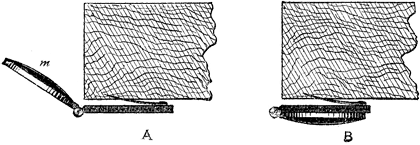
|
foreword to the online edition I. introductory II. common sharpers and their tricks III. marked cards and the manner of their employment IV. reflectors V. holdouts VI. manipulation VIII. the game of faro IX. prepared cards X. dice XI. high ball poker XII. roulette and allied games XIII. sporting houses XIV. sharps and flats
|
SHARPS AND FLATS
CHAPTER IV REFLECTORS
Table ReflectorAmong the more modern appliances, the first to which we shall refer is that known as the 'table- reflector.' As its name implies, it is designed for the purpose of being attached to the card-table during the game. It is thus described in one of the price-lists.
FIG. 20 From the many samples similar to the above with which one meets in 'sporting' literature, the legitimate inference is that punctuation-marks are an expensive commodity in certain districts of America. The reflector to which this paragraph refers is illustrated in fig. 20. It is a neat little contrivance, nicely finished and nickel-plated. The mirror m, as usual, is convex, forming as usual a reduced image of the card. A represents the position of the reflector whilst in use. B shows the manner in which it is turned back, out of the way and out of sight. The hinge is fitted with light friction-springs, which enable the mirror to retain any position in which it may be placed. It should be noted that all good shiners are convex. This ensures that the mirror will always catch the reflection of the card, as long as the shiner is oriented in the general direction. A flat mirror would be significantly more difficult to use, as the mirror would have to be more precisely oriented and tilted. Also, since a flat mirror does not reduce the reflected image, the surface of the mirror would have to be larger, thus requiring a much larger shiner, to catch the whole image. The correct way to 'play' the reflector is to press the steel point into the under side of the table, just sufficiently far back to bring the hinge about level with the lower edge of the table top. Whilst in use, the mirror, contrary to what one might suppose, is not inclined downwards, but the inclination given to it is an upward one as in the illustration. Thus, whilst the sharp is leaning slightly forward, as one naturally would, whilst dealing, the cards are reflected from the mirror as he looks back into it. Used in this manner, the reflector can be played anywhere, and even those who are familiar with 'shiners' will 'stand' it. Inclined downwards, it may be easier to use, but in that case the dealer would have to lean back whilst distributing the cards. A proceeding such as that would be liable to attract attention and to arouse suspicions which, all things considered, had better be allowed to slumber if the sharp is to maintain that mental quietude so necessary to the carrying out of his plans. It is possible of course that nothing of the kind may occur, but, on the other hand, it might. One cannot be too careful, when even the most innocent actions are apt to be misconstrued. The world is so uncharitable, that a little thing like the discovery of a bit of looking-glass might lead to a lot of unpleasantness. Who knows? Should anyone happen to come behind the dealer whilst the mirror is in view, it can always be turned out of sight with the little finger in the act of taking up one's cards from the table, or by sitting very close it can be altogether concealed.
|
| « reflectors | reflectors (pipe shiner) » |
home | introduction | book content | links | advertising | contact
